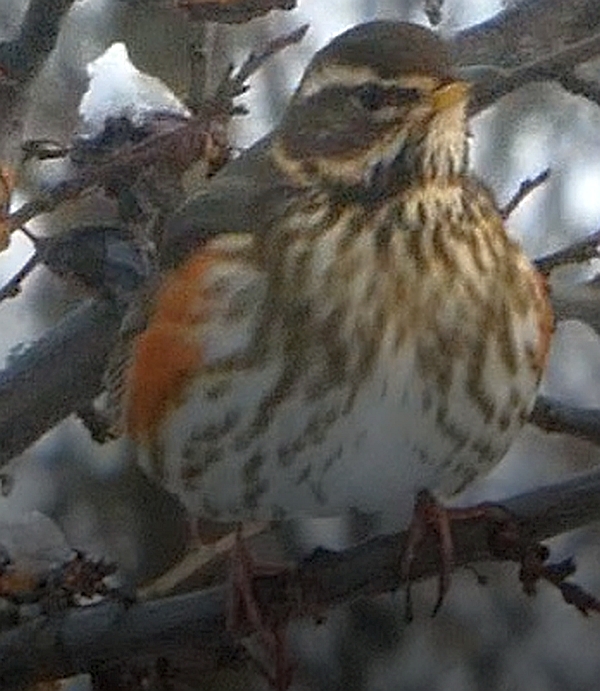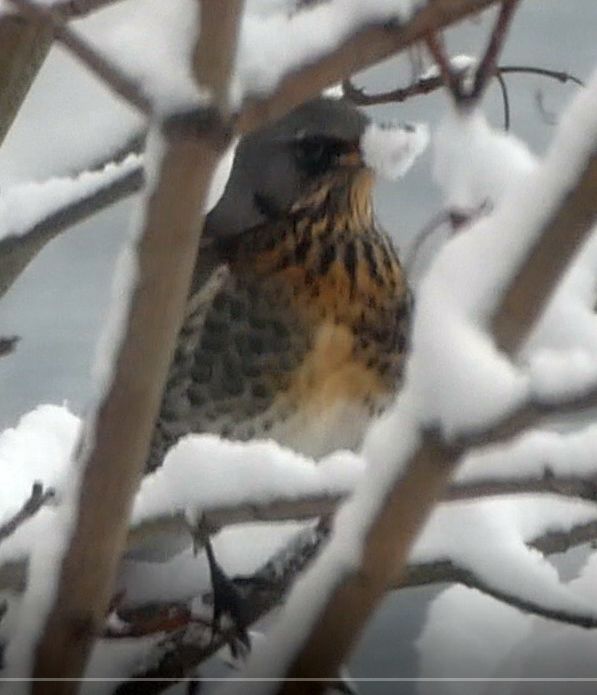1 or 2 fieldfares (gråtrost) normally overwinter in the garden and this winter has been no exception. They appear in autumn attracted to the cultivated and wild fruit. Fallen apples then become most important as the winter progresses. When the first deep snow arrives, I help them by putting out a few apples that makes it easier for them. The birds are very territorial, defending their cache of apples quite aggressively against other fieldfares. I put out apples in two parts of the garden which has lead to two birds overwintering. They are quite shy and have good vision, so only slight movement in windows puts them up. I’ve gradually moved the apples closer to the house and yesterday I put some apples on my balcony only a couple of metres from where I work….to my surprise, it wasn’t long before a bird found them and I made this video today!
Tag Archives: Gråtrost
Waxwings on apples
Waxwings (sidensvans) have arrived here in numbers with about 70 in the garden today! Most of their favourite berry, rowan (rogn) had gone by the time they arrived due to the large flocks of thrushes that were here a week ago (mainly fieldfares, redwings and blackbirds / gråtrost, rødvingetrost og svarttrost). They had opened up quite a few apples near the tops of the trees before they moved on, and now the waxwings are enjoying them – they luckily don’t try to open other apples, so that there are still many for us! We’ve been harvesting the last few days, but still a lot near the tops of the trees that are difficult to reach even with the apple picker!
Fall of thrushes
Thousands of thrushes, mainly redwings and fieldfares (rødvingetrost og gråtrost) arrived back in this part of Norway over the last couple of weeks and local breeders are already established in their territories. Both species breed right up to the tree line where there’s still a lot of snow and will forage for food on agricultural land until the snow disappears, mainly on higher ground. However, there’s been significant snow falls higher up and the snow line has moved back into the lowlands as is common at this time of year. Many of the new arrivals are then pressed down and concentrated on a narrow strip of lower ground near the fjord where there is only a sprinkling of snow which will disappear again during the day. This happened today and a large flock of very talkative birds arrived in the garden and some, mainly, redwings can be heard singing at the start and then many of the fieldfares take to flight in the second segment…
The Birds
Over the last couple of days there’ve been large numbers of birds in the garden making me think of Alfred Hitchcock’s The Birds, although there have been fortunately no casualties as far as I know. I try to limit the amount of bird food I put out (as its production isn’t good for birds) and it’s good to see that most species are still eating natural food.
This winter there’ve been reports from all over the county of unusual numbers of overwintering bramblings (bjørkefink) with flocks up to 300 birds recorded. I’ve had smaller flocks of 20-30 for some time, but yesterday they were everywhere in the garden and at least 140 birds were present, a new winter record for Malvik kommune! The films below show them both at the bird feeder, feeding on rowan berries (eating the seed and discarding the flesh) and also on the ground perhaps feeding on birch seed?
Apart from that there was a sizeable flock of some 60 waxwings (sidensvans) on guelder rose / krossved (Viburnum opulus) and hawthorn (hagtorn) , 11 bullfinches (dompap), 50 house sparrows (gråspurv), 6 goldfinches (stillits) still mostly on burdock seed, 16 siskins (on birch seed), 6 greenfinches (grønnfink), 2 hawfinches (kjernebiter) seen on plum stones and rowan berries, a single robin (rødstrupe), a couple of fieldfares (gråtrost) on apples and hawthorn, a great spotted woodpecker (flaggspett) and great and blue tits both establishing territories now. In addition, a flock of 500-600 jackdaws (kaie) fly over to the roost every evening.
Bramblings with a hawfinch:
Bramblings with a hawfinch feeding on rowan seed (at the end, both birds are seen to discard the flesh). A greenfinch was also feeding on rowan.
Bramblings on the ground (feeding on birch seed?)
Large flock of bramblings at the bird feeder:
Redwings
Eurasian redwings (rødvingetrost) seem to becoming more common in winter here. I now have 7 records of single birds since 2015 (December to March) and today there were 4 together feeding briefly with fieldfares (gråtrost) on guelder rose (krossved) berries! Interestingly, 27th December seems to be the best day to see redwings here as I now have records in 2015, 2017 and 2021 on this day!
Snow and fieldfare flock
A small flock of fieldfares (gråtrost) turned up in the garden today after a small snowfall. They were feeding on a few remaining guelder rose / krossved (Viburnum opulus) berries. A single resident fieldfare defended the elderberries, but allowed a blackcap (munk) to share the crop.
Fieldfare migration
With Covid a long way from being over, I’m wishing I was a bird! We probably won’t be visiting family in the UK this winter and this morning there were some 50 fieldfares (gråtrost) and a few redwings and blackbirds feeding on rowan berries in the garden and above I could witness thousands of thrushes passing the house towards west. On some autumn days thrushes will stream past all day in the same direction, maybe following the fjord. The weather chart shows perfect flying conditions with light north easterly winds between Norway and the UK, so I’m thinking these are bound where I can’t go…

Third day of snow
3 mornings in a row new snow has greeted me, but it mostly melts again during the day. I’m feeling for people in the north where the arctic city of Tromsø still has over 1m depth of snow and in the hills around here where the snow is accumulating. On the plus side I can still harvest for dinner in the afternoon and there’s entertainment with the abnormal numbers of birds in the garden foraging as open patches start appearing every morning. There are still several meadow pipits (heipiplerke) and many fieldfares (gråtrost) some coming right up to the house. This morning bramblings (bjørkefink) also made an appearance.
Fieldfare drinking snow

The return of the waxwings
The first two videos show waxwings eating apples opened up by fieldfares and blackbirds yesterday and also eating guelder rose (krossved) berries, so far not touching the elderberries (svarthyll).
Earlier in the day, the waxwings were hunting insects on birch trees and occasionally high into the air in pursuit of insects:
…and the morning after, they had discovered the yew berries!
…and on unharvested redcurrants (rips)….with a fieldfare (gråtrost) and brambling (bjørkefink) at the end of the video!
